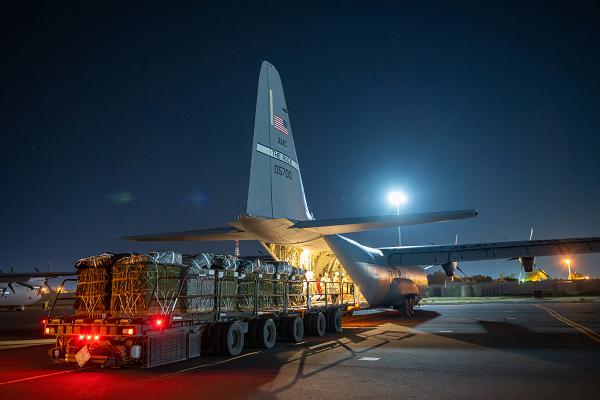
Southwest Asia. (March 23, 2024): The American military is launching a massive effort to send critical lifesaving supplies to the innocent citizens of Gaza as the Middle East war intensifies. In the above photo, a C-130J Super Hercules is loaded with over 38,000 Meals Ready to Eat (MREs) and water destined for an airdrop over Gaza as part of the U.S. Air Force’s rapid global mobility relief campaign.
The U.S. has conducted several humanitarian assistance airdrops into Gaza alongside the Royal Jordanian Air Force and the combined operations have delivered hundreds of thousands of badly needed meals to civilians. The U.S. decided to mount the air drops after more than 100 Palestinians, who had surged to pull goods off an aid convoy, were killed during a chaotic encounter with Israeli troops.
Three planes from Air Forces Central dropped sixty-six bundles into southwest Gaza on the beach along the territory’s Mediterranean coast. The airdrop was coordinated with the Royal Jordanian Air Force, which said it had two food airdrops Saturday in northern Gaza and has conducted several rounds in recent months.
Army Soldiers who specialize in the aerial delivery of supplies built the bundles and ensured they are dropped safely. The MREs— shelf-stable meals that contain a day’s worth of calories in each sealed package — were dropped in locations that were thought to provide civilians with the greatest level of safety to access the aid. Afterward, the U.S. monitored the sites and was able to see civilians approach and distribute food among themselves,
A C-130 can airlift as much as 42,000 pounds of cargo and its crews know how to rig the cargo, which sometimes can include even vehicles, onto massive pallets that can be safely dropped out of the back of the aircraft. Air Force loadmasters secure the bundles onto pallets with netting that is rigged for release in the back of a C-130, and then crews release it with a parachute when the aircraft reaches the intended delivery zone.
The C-130 is widely used to deliver aid to remote places due to its ability to land in austere environments. In past years, the Hercules has air dropped humanitarian aid into Afghanistan, Iraq, and Haiti and the airframe is used in the annual multi-national “Operation Christmas Drop” that air delivers pallets of toys, supplies, nonperishable food, and fishing supplies to remote locations in the Federated States of Micronesia and the Republic of Palau.
These U.S. airdrops are expected to be the first of many.


